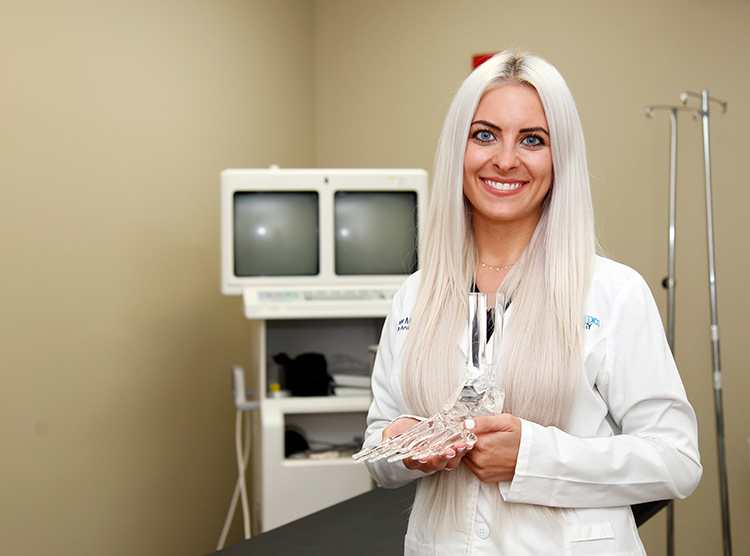
When your feet hurt, your body hurts.
We don’t fully appreciate how much we rely on our feet until they are not functional. Dr. Amber Morra, a foot and ankle surgeon at Vero Orthopaedics, knows this firsthand.
She grew up in Rhode Island playing hockey and soccer. When both feet were injured and required surgery, the procedure was life changing. “I got my life back when my feet were better,” she said. “I already knew I wanted to go into the medical field, but I wasn’t sure what specialty I would pursue. After my surgeries totally restored my quality of life, I decided I wanted to be a foot and ankle surgeon like the one who turned my life around.”
Dr. Morra joined Vero Orthopaedics in 2019, right after completing her fellowship in reconstructive foot and ankle surgery at University Hospitals in Ohio. While she is trained in the latest, most advanced surgical procedures, she prides herself on managing some conditions more conservatively.
“Because of the elderly demographics of the area, I’ve seen a lot of arthritis complaints since I’ve been here,” Dr. Morra said. “Technology has advanced so much in the last five years that we are able to treat arthritis and tendon tears with PRP or amnion injections to maintain motion without surgery. When we’ve exhausted conservative treatment options, then we move on to surgery.
“It used to be that bone fusion was the only option, but we’re now able to replace joints that we weren’t able to do in the past. We can replace joints in the big toe and replace the ankle joint completely.”
PRP (platelet-rich plasma) therapy uses injections of the patient’s own platelets to accelerate the healing of injured tendons, ligaments, muscles and joints. The injections are prepared by taking a few tubes of the patient’s own blood and running it through a centrifuge to concentrate the platelets. Those platelets are then injected directly into injured body tissue where they release growth factors to stimulate the production of reparative cells.
“Amnion injections are even better than PRP because they have stem cells,” explained Dr. Morra. “PRP is based on your own personal health, so logically, a 10-year-old would have a different PRP level than a 60-year-old. For those without optimal health, we choose an amnion injection because we know we are getting a better-quality injection for them.”
Dr. Morra also utilizes the innovative TenJet system to treat chronic pain caused by planter fasciitis or Achilles tendon injuries. While most tendon injuries heal on their own with rest, ice and physical therapy, if you’ve suffered more than 3 months your condition is considered chronic. In a chronic state, scar tissue begins to build up and the healing stops. When this happens, the damaged tissue needs to be removed to eliminate pain.
According to University Foot and Ankle Institute, under ultrasound guidance and local anesthesia, TenJet delivers a high-pressure stream of saline that differentiates between healthy and damaged tissue. The flow of the saline stream creates a suction effect that cuts and removes diseased tissue while sparing the healthy tendon.
“The TenJet machine only works on the damaged tissue, and by removing inflation and tearing it creates an acute environment which allows the body to repair itself,” said Dr. Morra. “The patient is weight-bearing immediately after the treatment.”
Ankle pain is usually associated with trauma and sports-related injuries such as a fracture or an injury to the ligaments of the ankle, such as a sprain; but it is also caused by arthritis.
If you are suffering from an ankle injury and experience sudden intense pain, even when you’re not weight-bearing, and the swelling persists or worsens after 2-to-3 days, you should consult a foot and ankle specialist. You should also seek treatment if you begin to feel feverish or the area reddens and becomes warmer and more sensitive, as these are signs of infection.
“Ankle replacement has been around for decades, but the quality of the implant has improved significantly in the past five years,” Dr. Morra said. “We now get CAT scans of the patient and design each implant specifically for that individual. An ankle replacement can take away the pain from arthritis and preserve the motion at the joint.”
Ankle replacement is the surgical removal of the bones and cartilage that make up the ankle joint. These are replaced with a metal piece in the tibia, another metal piece in the talus and a plastic piece between the two.
“The ankle is different than any other joint in the body,” Dr. Morra explained. “It’s a truly hinged joint and hinged joints can wear out. On the average you are looking at some type of revision every 10-to-15 years. The good news is that all we have to do is exchange the plastic part between the metal components. We don’t have to take the whole implant out.”
Dr. Morra treats a wide variety of foot and ankle conditions, including bunions, hammertoes, plantar fasciitis, sports injuries and tendon tears. “I’ve reconstructed an arch for a flat-footed child and even had to repair shark bite lacerations,” she said. “That’s something we don’t see every day. The fact that I can treat everything from ingrown toenails to joint replacements is gratifying and rewarding to me.”
Dr. Morra loves working with the Vero Orthopaedics team and is looking forward to moving into the practice’s new state-of-the-art facility on Indian River Boulevard this summer.
The new clinic will have its own surgery center where a patient can be treated as an outpatient or stay overnight to ensure the best personalized, one-on-one care. Vero Orthopaedics’ Hurt Today – Seen Today program enables anyone who calls before 4 p.m. with an acute injury to be seen that very day.
To schedule an appointment with Dr. Morra, visit www.veroortho.com or call 772-646-0106.



